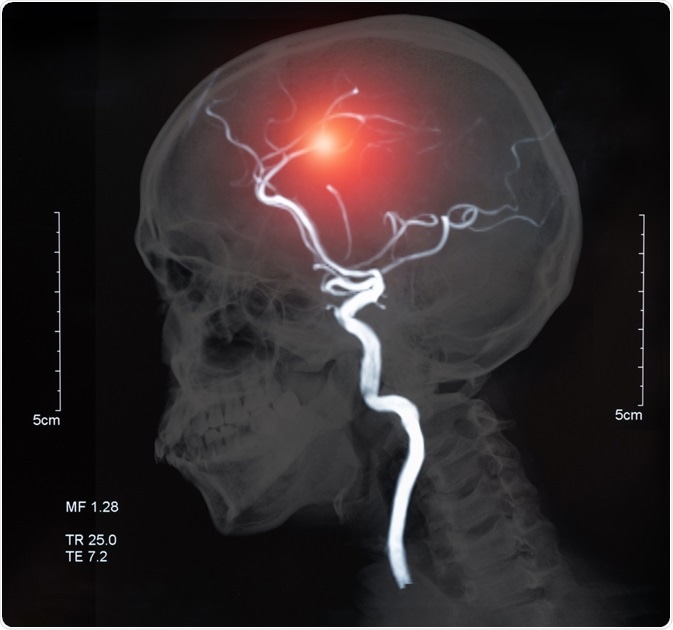Cerebrovascular disease refers to a variety of medical conditions affecting the blood supply to the brain.

Image Credit: create jobs 51/Shutterstock.com
Common cerebrovascular diseases include primarily stroke, in addition to vascular dementia, cerebral aneurysms, stenosis, and other vascular malformations.
Typically these conditions arise due to restricted blood flow to the brain either by narrowing of the arteries (stenosis), clots (thrombosis), blockages (embolism) or ruptures (hemorrhage).
Worldwide, cerebrovascular diseases account for the 2nd most common cause of death and the 6th most common cause of disability for survivors (estimated 31 million stroke survivors).
Causes of Cerebrovascular Disease
Cerebrovascular diseases can either be acquired later in life, and that may be preventable by the control of certain risk factors, or due to congenital defects that predispose or are directly causative of cerebrovascular damage.
Acquired cerebrovascular diseases are correlated with advancing age and can be directly related to the onset of atherosclerosis, aneurysms, and embolisms. The narrowing, rupturing or clotting within vessels can be caused by key risk factors including hypertension, obesity, type 2 diabetes, and smoking.
The consequences of these acquired changes to cerebral vessels lead to reduced oxygenation and perfusion of the whole brain or specific regions of the brain. There are, however, some risk factors such as advanced age, being male, being of black or South Asian descent and prior heart attack or stroke history that cannot be controlled for.
Genetically inherited, or congenital diseases can disrupt the integrity of cerebral arteries from birth, increasing the likelihood of developing cerebrovascular incidents in life. Predisposing conditions include CADASIL (cerebral autosomal-dominant arteriopathy with subcortical infarcts and leukoencephalopathy), caused by mutations to the Notch3 gene on chromosome 19, or germinal matrix hemorrhages, seen in premature infants who are yet unable to autoregulate cerebral blood flow.
Other conditions that can lead to cerebrovascular incidents include arteriovenous malformations, in which abnormally formed blood vessels have a higher rate of bleeding than a normal one, which can substantially increase the risk of hemorrhage.
Moyamoya disease is a progressive disease of the carotid arteries that can lead to irreversible blockage and hence blood flow to the brain. These patients tend to have higher incidences of strokes, vascular dementia and cognitive decline, seizures, and motor impairments.
When blood flow to the brain is disrupted (even for a few seconds), the brain tissue parenchyma can suffer from ischemia for a short while (inadequate blood supply). If the ischemia only lasts for a short time and can be re-perfused again, then a transient ischaemic attack (TIA) can occur, also known as a silent stroke.
If, however, the ischemia lasts several minutes or longer, the brain parenchyma suffers from infarction and tissue death (permanently).
Symptoms of Cerebrovascular Disease
Most symptoms of cerebrovascular disease are related to the symptoms of a stroke. The severity of the symptoms reflects the size of the area affected as well as how pronounced ischemia or infarction is.
Common stroke symptoms include:
- Numbness or weakness of a limb and/or face, usually unilaterally (one side)
- Loss of balance and coordination
- Severe headache, unlike anything you may have experienced before (hemorrhage or cerebral aneurysm)
- Slurring of speech or incomprehensible speech, as well as difficulty comprehending speech
- Other symptoms may also include confusion, memory loss, nausea and dizziness
Depending on the type and location of the brain region affected may also result in:
- Seizures (epilepsy)
- Migraines
- Cognitive impairments (dementia)
- Brain herniation if swelling occurs
With TIAs, the symptoms may be barely noticeable and may be brushed off. Over time, with repeated TIAs, the progressive decline may occur which may result in an ischaemic stroke.
Diagnosis and Management of Cerebrovascular Disease
Diagnosis of the different types of cerebrovascular disease can be made through different neuroimaging tests. Cerebral angiography is used to visualize the arteries of the head and neck, which are not normally seen using an x-ray.
Carotid ultrasounds can detect plaques and blood clots. CT scans are useful for detecting hemorrhagic strokes as blood is easily identifiable, though damage from ischaemic strokes cannot be seen immediately.
MRI can help determine signs of prior TIAs and changes to white matter in the brain as well as other cerebral diseases. Some tests can be used in combination with one another to reveal a more thorough image of the head and neck, including the vessels.
Further diagnosis can be made by performing a physical exam to assess physical ability/disability in addition to a neurological examination. Clinical history is also important to assess whether the symptoms are related to previous incidents or risk factors.
Treatments of the cerebrovascular disease include treatments for cardiovascular disease such as lifestyle changes (reducing alcohol intake, adopting a more active lifestyle with exercise, reducing cholesterol and fat, etc.), medications and surgery depending on the cause. Particular medications include aspirin (antiplatelet), warfarin (blood thinner), beta-blockers (antihypertensive) as well as anti-diabetic medications.
Future stroke risk can be minimized using endovascular and vascular surgery. In the case of carotid stenosis, carotid angioplasty and stenting may improve blood flow to the brain, or an endarterectomy to remove the plaque from within the vessel, which is then sutured.
In summary, cerebrovascular disease refers to conditions that affect the blood vessels and blood supply to the brain, potentially leading to cognitive decline, strokes, and death.
Many forms of the cerebrovascular disease can be prevented by adopting a healthy well-balanced lifestyle, in addition to medications, however, some forms are due to congenital defects present from birth which predispose individuals to higher incidences of cerebrovascular disease.
Depending on the type, severity, and location of the cerebrovascular disease, the prognosis may vary considerably from very poor/fatal in the case of ruptured aneurysms to almost near-normal life expectancy and health with a TIA.
Though repeated incidences of TIA may lead to vascular dementia and ischaemic stroke leading to permanent brain damage.
Further Reading